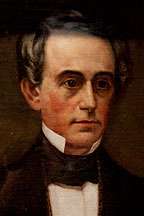Charles Cleveland Convers
Charles Cleveland Convers (July 26, 1810 – September 20, 1860) was a Republican politician in the U.S. State of Ohio who was Speaker of the Ohio Senate for two years and a judge on the Ohio Supreme Court for a short time.
Charles Cleveland Convers | |
|---|---|
 | |
| Associate Justice of the Ohio Supreme Court | |
| In office February 9, 1856 – April 11, 1856 | |
| Preceded by | Allen G. Thurman |
| Succeeded by | Ozias Bowen |
| Member of the Ohio Senate from the Muskingum County district | |
| In office December 3, 1849 – January 4, 1852 | |
| Preceded by | Charles B. Goddard |
| Succeeded by | William E. Finck (with Perry County) |
| Personal details | |
| Born | July 26, 1810 Zanesville, Ohio |
| Died | September 20, 1860 (aged 50) Zanesville, Ohio |
| Resting place | Woodlawn Cemetery, Zanesville, Ohio |
| Political party | Republican |
| Other political affiliations | Whig |
| Spouse(s) | Catherine Buckingham |
| Children | four |
| Alma mater | Ohio University Harvard Law School |
Biography
Charles Cleveland Convers was born at Zanesville, Ohio. He graduated from Ohio University and the Harvard Law School.[1] In 1849, he was elected to the Ohio Senate from Muskingum County, Ohio for the 48th General Assembly, which convened December 3, 1849. In January, 1850, Speaker Harrison G. Blake resigned, and Convers was chosen as his replacement. In 1850, he was re-elected, and again sat as Speaker in the 49th General Assembly.[2]
In 1851, when Ohio Supreme Court seats first became elective, Convers was unsuccessful as a Whig nominee.[3]
Convers was a member of the board of trustees of Ohio University from 1845 to 1849.[4]
In 1854, Convers was elected Judge of the Court of Common Pleas.[1] In 1855, the Republican State Convention nominated him for Judge of the Ohio Supreme Court. He defeated Democrat Robert B. Warden that year.[5] He served only a short time before resigning due to poor health. He died September 20, 1860.[1] Convers helped found Woodlawn Cemetery in Zanesville, where he is buried.[4]
Convers was married to Catherine Buckingham of Zanesville on April 14, 1839. They raised four children.[4]
Notes
References
- Smith, Joseph P, ed. (1898). History of the Republican Party in Ohio. I. Chicago: the Lewis Publishing Company.
- Ohio General Assembly (1917). Manual of legislative practice in the General Assembly. State of Ohio.
- Bell, William, Jr. (1876). Annual report of the Secretary of State to the Governor and General Assembly for the year 1875... Ohio Secretary of State.
| Legal offices | ||
|---|---|---|
| Preceded by Allen G. Thurman |
Associate Justice of the Ohio Supreme Court 1856 |
Succeeded by Ozias Bowen |
| Ohio Senate | ||
| Preceded by Charles B. Goddard |
Senator from Muskingum County 1849–1851 |
Succeeded by William E. Finck (with Perry County) |
| Preceded by Harrison G. O. Blake |
Speaker of the Senate 1850–1851 |
Succeeded by Position Eliminated |